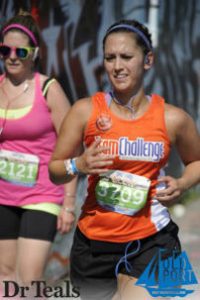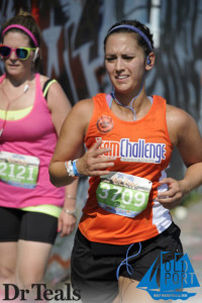What I Learned After Running Two Half Marathons (From a Novice Runner and Physical Therapist)

On Sat July 11th, I proudly completed my second half marathon! Not only did I run 13.1 miles on a really hot day in beautiful Portland, ME, but I ran this race with a group of amazing, inspiring, beat-all-odds individuals – my fellow teammates from Team Challenge. Team Challenge is the endurance training and fundraising program for the Crohn’s and Colitis Foundation of America(CCFA). Team Challenge teams are formed across the nation by different regions and together, we train to run one of a few select half marathon races, and raise much needed funds and awareness for Crohn’s Disease and Ulcerative Colitis. All of the money we raise goes to the CCFA, an organization who’s mission is to cure Crohn’s and Colitis, and they do this by sponsoring valuable research, and providing educational platforms that raise awareness. It’s a pretty awesome effort to be a part of, and it is always an amazing, heart-filled experience for me. Did I mention that a majority of the team members running actually have Crohn’s or Colitis?! They seriously inspire me. This year, we found out that my fiancé’s grandmother has Colitis – so the cause is especially near and dear to my heart. It was extra-important for me to cross that finish line this year so that I could support her, the friends I’ve made through Team Challenge, the relatives of close friends, and the millions of other Americans out there who suffer from Crohn’s or Colitis.
So what have I learned after running two half marathons?
1 – Anyone can run!
I used to hear this all the time and think: “yeah right, that’s a total lie…” Prior to my first race 2 years ago, I had never ran more than a mile. I’m not exaggerating. So you can imagine everyone’s surprise when I proudly announced that I was going to run a half marathon. But I did it! And I’ve been running ever since! All you need to run is some self discipline, will-power, a pair of good running shoes, and be in healthy base-line physical condition (you will want to check with your doctor first if you have any type of physical ailment, heart condition, or chronic illness).
If you want to start running and are brand new to the sport like I was, I highly recommend choosing a goal race and training with a schedule.
If you have a set goal in mind, you are less likely to quit when the running gets really hard – and believe me it will. Having a schedule to follow is also really helpful since it will keep you organized with your training and help you to pace yourself. Although I’ve never tried it myself (you know, because I decided to be crazy-ambitious and have my first race be a half marathon…!) I’ve heard great things about the couch to 5K program. A few friends of mine, and clients, have successfully used this program and enjoyed it. A 5K race is a lot of fun and a great first race to choose (a 5K race = 3.2 miles). Once you successfully run your first 5K and you decide to you want to run you first half, Hal Higdon has some practical and easy-to-follow training schedules for all levels. And of course you could always follow in my foot steps and choose a charity to run for! I love Team Challenge’s programs because they give you a schedule to follow, there are group trainings that you can attend once per week for your long runs, and you have ongoing support from runner’s coaches as well as mentors. Also, a lot of people running will be training for a half marathon for the first time in their lives just like you!
2. Strength training is a must
As you begin to fall in love with running, you quickly become addicted. Before you know it you are running 3-5x per week and feeling awesome! Running gets those endorphins flowing, it’s a great way to wake yourself up if you are a morning runner, and it helps to release the stress of the day if you are an evening runner. Plus, running is such a low maintenance way to feel great and stay in shape. You change your clothes, throw on your running shoes – and you are off! You can do it anywhere (it’s my method of choice for exploring new cities I visit) and don’t need a gym or fancy machines.
Ok then, if running feels so great, and is already taking up a good amount of your time, why do you need to add strength training on top of that? Because if you want to run faster, have better form, and lower your risk for injury, you must do strength training.
Even though almost every runner knows this, very few are able to discipline themselves to a dedicated strength routine every week. The reality is that no matter how great of a runner you are or how strong you might feel, the lack of strength training will eventually catch up to you in some way. It is how and why most runners end up on my treatment table. When you lack the adequate muscle strength (read: balanced muscle strength) to keep up with the demands you are putting on your body through running, your brain and body begin to notice this. You automatically adapt to any imbalances or inefficiencies, however subtle they may be, by creating compensatory patterns. A common example of this is the tensor fascia Lata (TFL) taking over for weak gluteal muscles, which leads to the common problem known as iliotibial band syndrome (you can read my article on that here). Our bodies don’t like to do anything over and over again, and that includes running. You can significantly minimize injuries, and wear-and-tear on your body by arming yourself with a well-balanced and varied strength routine. The best way to ensure that you will get your strength training in is to hire a personal trainer. Paying in advance for appointments and having that on your calendar every week ensures accountability. A personal trainer will also help you to vary your routine better than you probably will on your own.
3. Pilates is an AWESOME form of cross-training for runners
Pilates is an exercise system developed by Joseph Pilates that is easy on the joints and heaven for the body! It emphasizes all of the small, tiny muscles in your body responsible for quick movement and stability. These muscles quite often get over-powered and compensated for with running. Pilates helps to improve your flexibility and coordination. This is partciularly important for your form. Since running is an activity of efficiency, when you run with better form your muscles can react to the automation of running rather than having to work every second of the run. When they aren’t wasting energy trying to compensate for poor form, they can work longer and harder for you when you need them to get up hills and sustain those longer distances. Pilates also helps to optimize your breathing. We all know how important breathing is while you are running. When you do Pilates regularly, you learn how to optimize your breath with your deep core, which is really helpful for all sports and activities, not only running.
Runners, if you aren’t doing Pilates, then you are missing out.
I’m not saying this from personal experience only. I’m saying this because I’m an expert in helping people re-balance their bodies and teaching people how to connect in with their deep stabilizing muscular systems – and Pilates makes my job that much easier. The first time I trained for a half marathon, I did Pilates once per week using the machines (reformer, chair and cadillac). My runs felt much more energetic and free-flowing, and my Pilates workouts were such a great release for my body in comparison to the the wear and tear from running. To be honest, I never gave much thought to how valuable Pilates was to my running until THIS year, when I wasn’t able to get in very many Pilates workouts. It certainly wasn’t because I stopped loving Pilates! I simply just couldn’t get my act together this year to schedule in my workout!
One of my favorite Pilates workouts to do with runners is jump board on the reformer. Most runners don’t consider Pilates when they are thinking about cross-training because it doesn’t seem “aerobic” enough. Trust me, your heart rate will definitely rise on the jump board and your legs and abs will BURN! Even though you are jumping, it is still easy on the joints because you are lying down on the machine and only a fraction of the force goes through your joints compared to running. Jump board workouts also give you the opportunity to really focus on the alignment of your hips, knees and feet as you land on the ground. This is particularly important for improving foot awareness and articulation, something that all runners could really benefit from. If what you are reading really intrigues you and you are thinking about bringing Pilates into your life (you totally should), I highly highly recommend finding a certified Pilates instructor to work with privately in the beginning. There is a little bit of a learning curve to Pilates if you have never done it before, and it will be a much more fulfilling experience for you if you learn how to do it correctly from the very beginning. Even though there are some great youtube clips and videos out there on Pilates, it just doesn’t compare to what working with a private instructor will be able to accomplish for you. If you are suffering from any kind of injury, then working with a physical therapist who is certified in Pilates (like me!) is your best bet. While Pilates instructors are trained very well (they go through about 700 hours of training before then can become certified), they don’t have the problem-solving knowledge that physical therapists have when it comes to navigating your injury.
Well there you have it – a few things I learned from running two half marathons! I hope this information encourages you to get out there and give running a try if you are new to the sport like I was a few years ago. I also hope that you learned some valuable information that will keep you from getting injured and help you to run in your best and healthiest way possible!
Until next time, keep moving and move well!
Carrie



